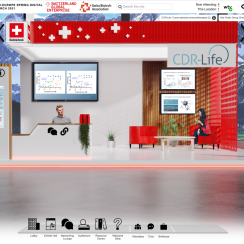The past two years have had a major impact on the trade fair industry, with many events being canceled, postponed or held digitally. However, most travel restrictions have now been lifted and established international trade fairs are once again attracting visitors from all over the world. After the lengthy hiatus, it is all the more evident: in sales, the value of personal contacts and informal exchange cannot be overestimated. The resumption of trade fair appearances offers companies the opportunity to present their products abroad and test new markets. Personal contact is especially important for complex business transactions in order to first gain the trust of new customers and to bring sales talks to a conclusion.
Digital trade fairs - advantages and limitations
After the outbreak of the pandemic, fair organizers and exhibitors had to respond quickly to the changed conditions with new offers and formats - a wide variety of digital and virtual platforms was launched as trade fair substitutes. The past two years have demonstrated the advantages of digital trade fairs but simultaneously also shown where they reach their limits. The benefits clearly include time and cost savings. It is possible to participate in several events at the same time, without wasting time or money traveling. Another advantage is the extensive reach that can be achieved with digital formats. You can connect with target groups that would otherwise have been unreachable - for example, participants from China at a digital trade fair in Germany who would not have traveled all the way to Germany for one day. Something else of great value is that exhibitors learn more about their customers and their needs, thanks to tracking.
However, digital formats reach their limits when it comes to establishing personal contact and trust. The shared experience and informal, spontaneous networking are missing. Comprehensive product presentations are also not possible. Something else that is also more challenging in the digital world is the customer approach. Visitors must first be found and encouraged to interact. Exhibitors are reliant on visitors finding them in a directory and contacting them proactively, whereas at a physical trade fair they can also benefit from chance encounters and walk-in visitors.
Opportunities and challenges of the new trade fair trends
The trade fair format of the future combines the best of the physical and digital worlds. Despite the limitations of digital trade fairs, the associated experiences are very valuable and have accelerated further development in the trade fair industry. The trade fair is turned into an overall experience: it doesn’t just take place over a few days at a specific location, but offers visibility within a digital community 365 days a year. By adding digital components to the physical trade fair presence, trade fair participation is being taken to the next level, benefiting both visitors and exhibitors.





